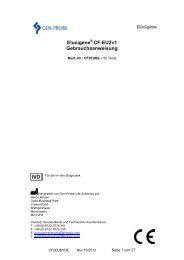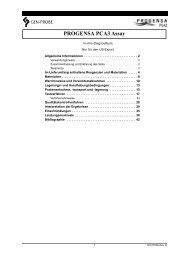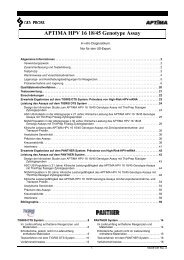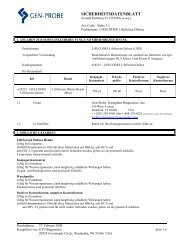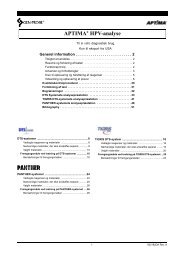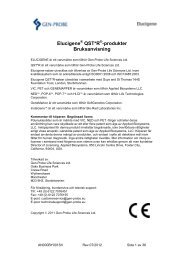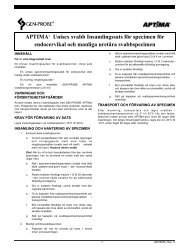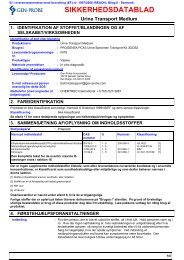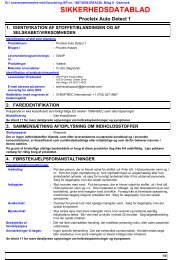APTIMA Trichomonas vaginalis Assay - Gen-Probe, Inc.
APTIMA Trichomonas vaginalis Assay - Gen-Probe, Inc.
APTIMA Trichomonas vaginalis Assay - Gen-Probe, Inc.
You also want an ePaper? Increase the reach of your titles
YUMPU automatically turns print PDFs into web optimized ePapers that Google loves.
TIGRIS DTS System Test Procedure<br />
TIGRIS DTS System Test Procedure<br />
Note: See the TIGRIS DTS System Operator’s Manual for additional TIGRIS DTS System<br />
procedural information.<br />
A. Work Area Preparation<br />
1. Clean work surfaces where reagents and samples will be prepared. Wipe down work<br />
surfaces with 2.5% to 3.5% (0.35 M to 0.5 M) sodium hypochlorite solution. Allow the<br />
sodium hypochlorite solution to contact surfaces for at least 1 minute and then follow with<br />
a water rinse. Do not allow the sodium hypochlorite solution to dry. Cover the bench<br />
surface on which the reagents and samples will be prepared with clean, plastic-backed<br />
absorbent laboratory bench covers.<br />
B. Reagent Reconstitution/Preparation of a New Kit<br />
Note: Reagent reconstitution should be performed prior to beginning any work on the TIGRIS<br />
DTS System.<br />
1. To reconstitute Amplification, Enzyme, and <strong>Probe</strong> Reagents, combine the bottles of<br />
lyophilized reagent with the reconstitution solution. If refrigerated, allow the reconstitution<br />
solutions to reach room temperature before use.<br />
a. Pair each reconstitution solution with its lyophilized reagent. Ensure that the<br />
reconstitution solution and lyophilized reagent have matching label colors before<br />
attaching the reconstitution collar.<br />
b. Check the lot numbers on the Master Lot Barcode Sheet to ensure that the<br />
appropriate reagents are paired.<br />
c. Open the lyophilized reagent vial and firmly insert the notched end of the<br />
reconstitution collar into the vial opening (Figure 1, Step 1).<br />
d. Open the matching reconstitution solution bottle, and set the cap on a clean, covered<br />
work surface.<br />
e. While holding the reconstitution solution bottle on the bench, firmly insert the other<br />
end of the reconstitution collar into the bottle opening (Figure 1, Step 2).<br />
f. Slowly invert the assembled bottles. Allow the solution to drain from the bottle into the<br />
glass vial (Figure 1, Step 3).<br />
g. <strong>Gen</strong>tly swirl the solution in the vial to mix. Avoid creating foam while swirling the vial<br />
(Figure 1, Step 4).<br />
h. Wait for the lyophilized reagent to go into solution, then invert the assembled bottles<br />
again, tilting at a 45° angle to minimize foaming (Figure 1, Step 5). Allow all of the<br />
liquid to drain back into the plastic bottle.<br />
i. Remove the reconstitution collar and glass vial (Figure 1, Step 6).<br />
j. Recap the plastic bottle (Figure 1, Step 7). Record operator initials and reconstitution<br />
date on the label.<br />
k. Discard the reconstitution collar and glass vial (Figure 1, Step 8).<br />
<strong>APTIMA</strong> <strong>Trichomonas</strong> <strong>vaginalis</strong> <strong>Assay</strong> 12 502246 Rev. B



